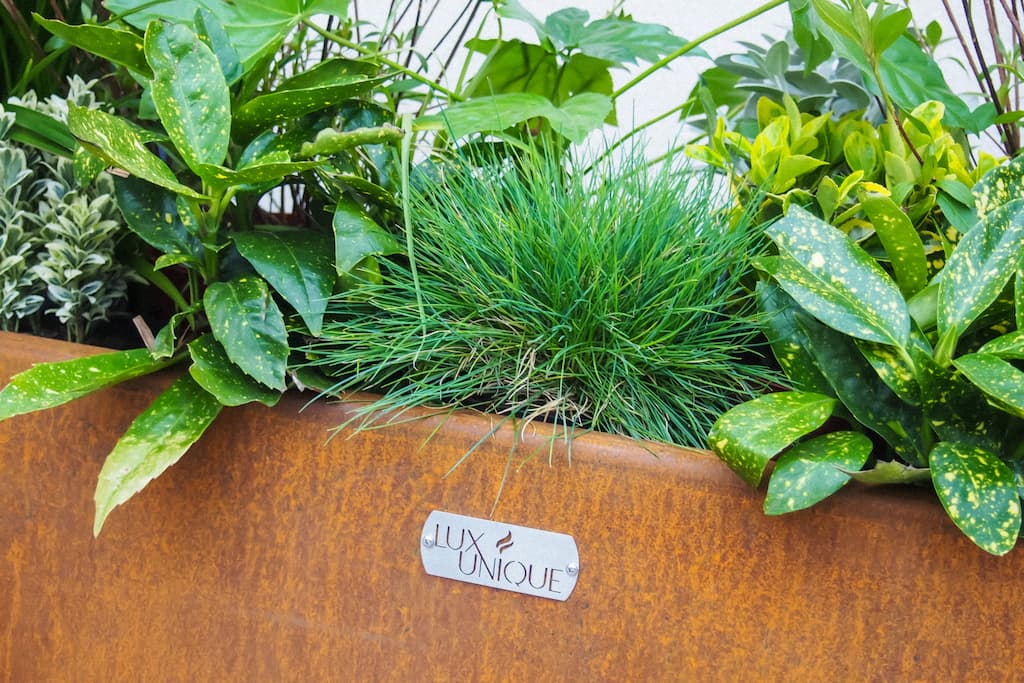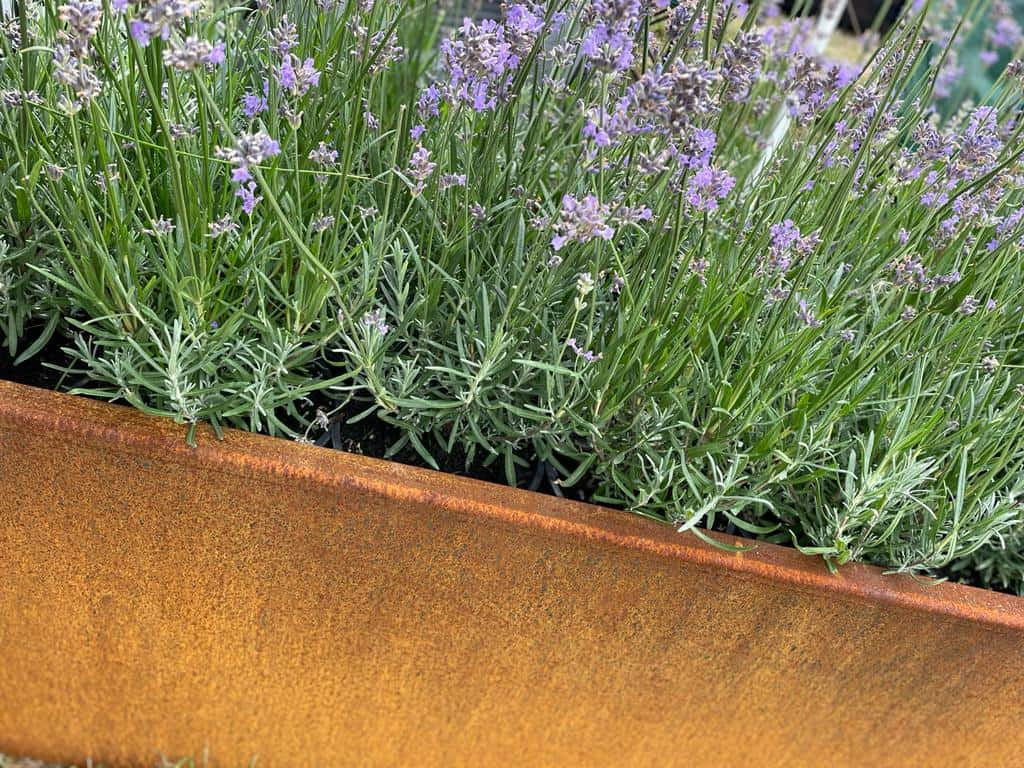What Plants go well with Corten Steel?
What plants go well with Corten Steel?
Corten steel is known for the distinctive orange-brown hue it takes on once it has completed its months-long weathering process. Because this can be a very dominant, strong colour, it can be difficult to know just what plants will gel with it. In this guide, we will take a look at some ideas for what colours might work well with your corten steel planter, edging, retaining wall, or even water feature.

Contents
The colour wheel
First up, a note on the colour wheel which is probably included in the category of Garden Design 101. Basically, it puts all the colours of the rainbow in a circle, with ‘complementary’ colours (like orange and blue) opposite each other, and harmonious colours (like orange and yellow) next to each other. Generally speaking, complementary colours will give more of a ‘pop’ to your planting scheme, while harmonious colours will do just that – work more in harmony.
Don’t forget foliage
It’s easy to forget the role that foliage plays when thinking of colour in the garden – which is a bit silly when you think about it! Even a plant with a long flowering season will only have flowers for a few months, whereas the foliage could be around all year.
Foliage colour can also change with the seasons and be a focal point in its own right. Alternatively, it may serve as a backdrop for blooms. Happily, shades of green, such as blue-green, are pretty much opposite orange on the colour wheel so some foliage plants offer great complementary colours.
4 complementary plants
Purple Lavender
Lavender is a plant that, as the name suggests, usually has flowers in a blue-purple so gives a complementary feel. It is ideal for your corten steel planter as it likes good drainage so even if you have heavy clay soil you can adapt the soil to its needs.
Lavender also has beautiful blue-green foliage that stays put even in winter long after the mid-to-late-summer flowers have gone. This will provide a slightly more harmonious complementary hue throughout the year.
To extend the life of your lavender and help it retain a nice bushy appearance, it is worth going over plants with pruning shears in September to remove fading blooms and some foliage. Try to leave at least an inch of new growth as plants can be reluctant to sprout from old wood.

Blue Agapanthus
Agapanthus are perhaps the kings of the inky blue (although there are also white ones), which contrasts beautifully with the orange of corten steel, and have half globe-shaped clusters of starry flowers in midsummer.
They come in two main types: evergreen and deciduous. Deciduous ones are hardier and shouldn’t require any winter protection, while the evergreen ones probably will and are often grown in large pots and taken into a frost-free place in winter.
Salvia ‘Amistad’
Salvia ‘Amistad’ is a plant that’s wildly popular in planting schemes. And there’s a reason for that popularity as it has a long flowering season during which it bears impressive spikes of purple flowers. It also likes a sunny spot and free-draining soil and is generally hardy in all but the most severe winters. It is, thankfully, easy to propagate from cuttings and is also loved by bees!
Purple and blue Lupin
These plants tend to flower a little earlier in the season than the aforementioned trio. They are traditionally a cottage garden plant but also work well in a more contemporary setting. They also prefer a more moist soil than the plants we’ve mentioned thus far.
Lupins have spires of pea-like flowers and are best placed towards the back of a planter or border. They also come in pinks and oranges, which leads us on nicely to a trio of harmonious colour combos…
3 harmonious plants
Bronze Carex
More specifically Carex varieties such as Carex comans ‘Bronze Form’ which, yes you’ve guessed it, has bronze foliage, which is grass-like and stays on the plant throughout the year. It tolerates most soil types and aspects and will benefit from a ‘comb through’ to remove dead foliage in spring.
A short plant, ‘Bronze Form’ will be right at home lolling over the edge of some corten garden edging.
Orange Geum
Geums are another early summer staple in cottage gardens and produce long sprawling flower stems with, usually orange, flowers above tussocks of green foliage. It is orange varieties such as ‘Totally Tangerine’ that will harmonise best with corten retaining walls or planters.
They are fairly tolerant with regard to soil type and aspect and will grow in anything from sandy to clay soil and from sun to semi-shade.
Rudbeckia
There really are loads of Rudbeckias that would work well with corten steel as they come in a range of harmonious colours from red, through orange, to yellow. A variety such as ‘Enchanted Flame’ can be a short-lived perennial with orange-red flowers, while R. ‘Summerina Orange’ is said to be hardier as it incorporates some Echinacea genes.
Both Rudbeckias and Echinaceas have daisy-like flowers emerging from a cluster of green leaves. Rudbeckias will flower from midsummer well into autumn.
And a pond plant…
Water iris
A blue or purple water iris will look just grand next to a corten water feature, pond, or trough filled with water. They are marginal plants that thrive at the edge of a pond, perhaps planted in an aquatic basket, and like to have a rich moist soil. They are perennial and fully hardy with flower spikes emerging in late spring to early summer.
And one last foliage plant…
Hosta ‘Halcyon’
Hostas are renowned as epic foliage plants and come in colours including almost countless shades of greens and yellows. However, there are some blue-grey forms and ‘Halcyon’ is one, with its leaves contrasting well against corten steel in the middle or front of your planters. It will grow best in light shade with some sun in the morning or late evening.
Like all hostas, slugs like to chew on the leaves, although growing them raised off the ground in corten steel containers should help quite a bit with this!
A matter of personal taste
Of course, there are many more plants that contrast with, or harmonise with, corten steel troughs and planters. At the end of the day, what goes well is partly a matter of personal preference but we hope some of the selections above have given you food for thought. And yes: don’t forget vegetables and herbs too. How about rosemary and trailing toms for starters!
